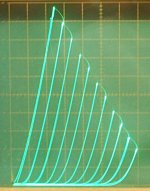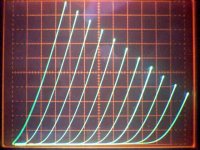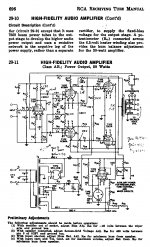I would look for a possibility to divide the primary and put parts of the winding into the cathode. This resembles "ultra linear" with additional cathode fb. Ug2 and Ug1 should be preferable stabilized, with fixed bias for class B this is a must. Compared to tetrode/pentode mode with high gm/low Ug2 tubes this results in the following: Ug2 and Ug1 can be lifted up to the max allowed when triode connected. Real Ra and Pout somewhere between triode and pentode mode. Effective Ra further lowered due to addional cathode fb. Lower distortion than either triode or pentode Lower Ceff of the OPT and higher BW. Effective Cin lower than pentode mode and much lower than triode.
Offcourse this all comes at a cost, your driver must be capable of delivering the now higher voltage demanded by the partial triode mode + cathode fb. Special attention must be given to potential Rf-issues!
Offcourse this all comes at a cost, your driver must be capable of delivering the now higher voltage demanded by the partial triode mode + cathode fb. Special attention must be given to potential Rf-issues!
The CFB derived UL is a nice solution, but requires an OT that is rather rare or custom made. Using the secondary for the CFB winding gives too low a CFB ratio to be very useful and puts the speaker load non-symmetrically across the winding.
For someone who is stuck with an OT with no UL tap, I would just use an LTP -triode- driver stage (could be a pentode on the actual drive side for more loop gain), with N Fdbk from the output tube plate back to the unused LTP triode plate. So using the inverse Mu of the LTP triode as the N Fdbk attenuator. That makes the output tube (presumably a pentode) into a power triode with the Mu of the driver tube and the -full- power of the pentode tube. (unlike UL)
For P-P one would use a pentode LTP driver with the N Fdbks taken back to the screens (via R dividers) of the LTP. (and crossed over for phase) The driver pentode tubes then need to be quite linear (when tested in triode mode). And the N Fdbk needs to be scaled so that the screens draw current proportional to screen V (driver Vscrn proportional to driver Vplate, so looking like resistive loads). Otherwise Mosfet followers are needed for the screens.
Best (most linear) pentode driver tube (in triode) I have seen is the 12HL7, Mu 25 to 30 depending on brand (curves below for a selected 12HL7, frame grid tubes must be curve tracer selected) ( Easily outclassing a 300B using just $4 TV sweep tubes for the outputs ) An alternative driver is the direct heater 1E7G, Mu 10 (2nd curves below)
Alternatively, the P-P N Fdbks can be taken back to the driver cathodes, similar to the RCA 50 Watt handbook amplifier (the shunt "Schade" loops optional). No longer any pretension of emulating power triodes for the outputs then, just high "local" (no OT in loop) N-Fdbk.
For someone who is stuck with an OT with no UL tap, I would just use an LTP -triode- driver stage (could be a pentode on the actual drive side for more loop gain), with N Fdbk from the output tube plate back to the unused LTP triode plate. So using the inverse Mu of the LTP triode as the N Fdbk attenuator. That makes the output tube (presumably a pentode) into a power triode with the Mu of the driver tube and the -full- power of the pentode tube. (unlike UL)
For P-P one would use a pentode LTP driver with the N Fdbks taken back to the screens (via R dividers) of the LTP. (and crossed over for phase) The driver pentode tubes then need to be quite linear (when tested in triode mode). And the N Fdbk needs to be scaled so that the screens draw current proportional to screen V (driver Vscrn proportional to driver Vplate, so looking like resistive loads). Otherwise Mosfet followers are needed for the screens.
Best (most linear) pentode driver tube (in triode) I have seen is the 12HL7, Mu 25 to 30 depending on brand (curves below for a selected 12HL7, frame grid tubes must be curve tracer selected) ( Easily outclassing a 300B using just $4 TV sweep tubes for the outputs ) An alternative driver is the direct heater 1E7G, Mu 10 (2nd curves below)
Alternatively, the P-P N Fdbks can be taken back to the driver cathodes, similar to the RCA 50 Watt handbook amplifier (the shunt "Schade" loops optional). No longer any pretension of emulating power triodes for the outputs then, just high "local" (no OT in loop) N-Fdbk.
Attachments
Last edited:
Hugh Alvon Lochart.....http://mirror.thelifeofkenneth.com/...ansformer_Thesis_Hugh_Alvin_Lockhart_text.pdf
The CFB derived UL is a nice solution, but requires an OT that is rather rare or custom made. Using the secondary for the CFB winding gives too low a CFB ratio to be very useful and puts the speaker load non-symmetrically across the winding.
My suggestion was to look for a possibility to use 1 or 2 layers (preferable outer layers) of the primary and feed it from the cathode. I was lucky more often than once to do so with standard pp OPTs from Jensen, Philips and others from unknown producers. It all depends on the actual build of the transformer offcourse.
- Status
- Not open for further replies.


